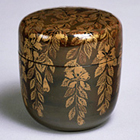Japanese Gallery (Honkan) Room 12
March 15, 2011 (Tue) - June 5, 2011 (Sun)
As the cold of early spring softens, cherry blossoms color the landscape. The joy of viewing these scenes is fleeting, however, as the blossoms soon fall. Perhaps it is precisely this bittersweet sense of valor and transience that strikes a chord in our hearts. In classical waka poetry, the word "flowers" refers to cherry blossoms. From ancient times, Japanese people from all walks of life have delighted in cherry-blossom viewing.
In lacquerware, cherry blossom motifs were relatively slow to emerge, with the earliest examples dating from the Muromachi period (1392-1573). Later, in early modern times, works featuring cherry blossoms were produced in great numbers, and cherry blossoms came to be a typical motif in Japanese lacquerware. Many masterpieces of maki-e lacquerware feature designs based on classical literature, some of which incorporate cherry blossom motifs. Key examples include writing boxes and other such wares, their designs symbolically representing cherry-blossom sites immortalized in waka poetry, such as Hatsuse in Nara prefecture and Hira in Shiga prefecture.
Through a broad array of lacquerware with motifs rendered in a variety of techniques, this exhibition shows how cherry blossoms have long been cherished by the Japanese people.

